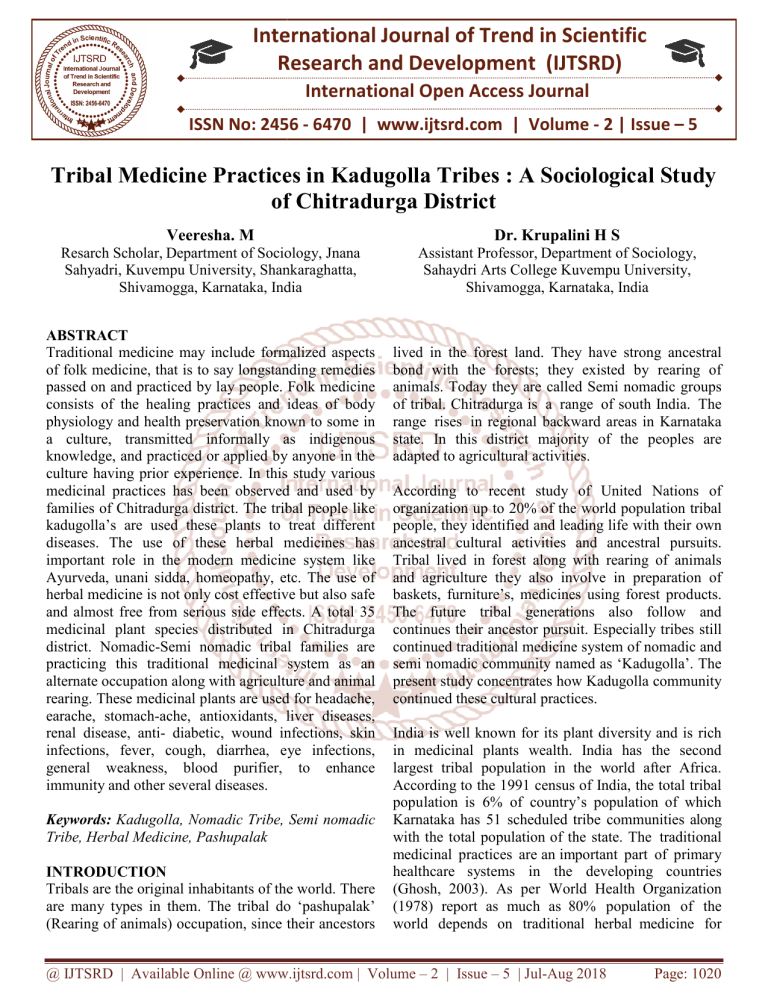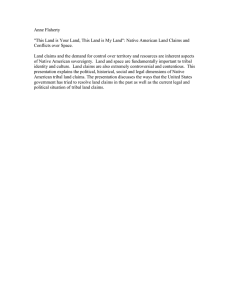
International Journal of Trend in Scientific
Research and Development (IJTSRD)
International Open Access Journal
ISSN No: 2456 - 6470 | www.ijtsrd.com | Volume - 2 | Issue – 5
Tribal Medicine Practices
ractices in Kadugolla Tribes : A Sociological Study
off Chitradurga District
Veeresha. M
Dr. Krupalini H S
Resarch Scholar, Departmentt of Sociology, Jnan
Jnana
Sahyadri, Kuvempu University, Shank
Shankaraghatta,
Shivamogga, Karnataka, India
Assistant Professor, Departmen
artment of Sociology,
Sahaydri Arts
rts College Kuvempu University,
Shivamogga, Karnataka, India
ABSTRACT
Traditional medicine may include formalized aspects
of folk medicine, that is to say longstanding remedies
passed on and practiced by lay people. Folk medicine
consists of the healing practices and ideas of body
physiology and health preservation known to some in
a culture, transmitted informally as indigenous
knowledge, and practiced or applied by anyone in the
culture having prior experience. In this study various
medicinal practices has been observed
bserved and used by
families of Chitradurga district. The tribal people like
kadugolla’s are used these plants to treat different
diseases. The use of these herbal medicines has
important role in the modern medicine system like
Ayurveda, unani sidda, homeopathy,
pathy, etc. The use of
herbal medicine is not only cost effective but also safe
and almost free from serious side effects. A total 35
medicinal plant species distributed in Chitradurga
district. Nomadic-Semi
Semi nomadic tribal families are
practicing this traditional
itional medicinal system as an
alternate occupation along with agriculture and animal
rearing. These medicinal plants are used for headache,
earache, stomach-ache,
ache, antioxidants, liver diseases,
renal disease, anti- diabetic, wound infections, skin
infections,
ns, fever, cough, diarrhea, eye infections,
general weakness, blood purifier, to enhance
immunity and other several diseases.
Keywords: Kadugolla, Nomadic Tribe, Semi nomadic
Tribe, Herbal Medicine, Pashupalak
INTRODUCTION
Tribals are the original inhabitants of the world. There
are many types in them. The tribal do ‘pashupalak’
(Rearing of animals) occupation, since their ancestors
lived in the forest land. They have strong ancestral
bond with the forests; they existed by rearing of
animals. Today they are called Semi nomadic groups
of tribal. Chitradurga is a ran
nge of south India. The
range rises in
n regional backward areas in Karnataka
state. In this district majority of the peoples are
adapted to agricultural activities.
According to recent study of United Nations of
organization up to 20% of the world population tribal
people, they identified and leading life with their own
ancestral cultural activities and ancestral pursuits.
Tribal lived in forest along with rearing of
o animals
and agriculture they also involve in preparation of
baskets, furniture’s, medicines using forest products.
The future tribal generations also follow and
continues their ancestor pursuit. Especially tribes still
continued traditional medicine system
syst of nomadic and
semi nomadic community named as ‘Kadugolla’. The
present study concentrates how Kadugolla community
continued these cultural practices.
India is well known for its pla
lant diversity and is rich
in medicinal plants wealth. India has the second
largest tribal population in the
t
world after Africa.
According to the 1991 censuss of India, the total tribal
population is 6% of country
y’s population of which
Karnataka has 51 scheduled tribe
tri communities along
with the total population of th
he state. The traditional
medicinal practices are an im
mportant part of primary
healthcare systems in the developing countries
(Ghosh, 2003). As per World
Wor Health Organization
(1978) report as much as 80%
80
population of the
world depends on traditional herbal medicine for
@ IJTSRD | Available Online @ www.ijtsrd.com | Volume – 2 | Issue – 5 | Jul-Aug
Aug 2018
Page: 1020
International Journal of Trend in Scientific Research and Development (IJTSRD) ISSN: 2456-6470
their primary healthcare necessities (Azaizeh et al.,
2003). The tribal people don`t have much knowledge
of the education but they have the knowledge of
traditional medicines and their uses as the remedies to
various diseases. This knowledge is transmitted from
one generation to the next generation.
METHODOLOGY:
Research topic: Tribal Medicine Practices in Kadugolla Tribes: A
sociological Study of Chitradurga District.
Objectives:
To study the historical background of the
traditional medicine system.
To study nature of the Kadugolla tribal medicine
system by using plant products.
To identification of Plant species, parts used and
treating diseases.
To study different types of tribal medicine
treatments in Kadugolla community.
Methods of the study:
In the present study, the field work has been carried
out by using special methods in order to collect
information from the tribal’s regarding the various
practice of traditional medicinal system. Hence I have
selected some of the villages as a study area. I
gathered both qualitative quantitative data through the
observations, questionnaire, interview schedule, and
purposive sampling. Secondary data was collected
from various University libraries, literature survey
and internet data.
Analysis of the data:
In my field work, I have collected qualitative and
quantitative information for the analysis of
information we are using for the research tools,
coding, decoding, tabulation etc.
Table-1: Plants used for medicinally by Nomadic or Semi nomadic tribe of Kadugolla in Chitradurga
Ailments
Scientific/Local
Medicine Preparation
Types of Treatments of Medicine.
Names and Parts
Used.
Food
Hibiscus saddariffa.
A few sepals are boiled in a
The infusion of sepals is given to the
Poisoning
Khatti pendi. Sepals.
glass of water.
patient which leads to vomiting.
Epilepsy
Commelina
20gm Powder of roots is
Two pills in a day one in the morning
bengalensis linn.
mixed with the equal amount and one in the evening for 6-7 days in
Mothi deni. Roots.
of jaggary and small sized
case of adults and one pills in a day in
pills are prepared.
case children and women.
Prevention of A)Daucus carota Linn. 70gms seeds are ground to
5gms seed powder is given to the
Pregnancy
Gajar.
powder.
women twice a day for 14day from
Seeds.
the 4th day of menstruation.
Spoonful powder is given to the
B)Syzygium
Bark in the west side of the
heyneanun. Lahan
tree is removed and
women as a single dose on the 5th day
jamun. Bark.
powdered.
of menstruation.
Fistula
Achyranthes aspera
The leaves are crushed and a Leaves paste applied externally at
Linn Aghanda.
paste prepared
night until relief is felt.
Leaves.
Kidney
Ensete superbum
Fresh tender peduncle is cut
About half foot peduncle raw it leads
Stone
cheesm. Jangli keli.
and used
to excessive urination and later relief
Fresh tender.
is felt from kidney stone.
Diabetes
A) Gymnema
Fresh leaves are plucked in
One leaf is eaten as such in the
Sylvestre. Bedki.
the early morning.
morning for 5days.
Fresh leaves.
B) Calotropis
Fresh flowers are plucked in 7flowers are eaten every morning for
gigantean. Rui. Fresh the early morning
21 days.
flowers.
Skin
Cassia tora. Powadya. Seeds are finely powdered
This paste is applied on affected part
Diseases
Seeds.
and mixed in coconut oil to
till cured.
prepare a paste.
@ IJTSRD | Available Online @ www.ijtsrd.com | Volume – 2 | Issue – 5 | Jul-Aug 2018
Page: 1021
International Journal of Trend in Scientific Research and Development (IJTSRD) ISSN: 2456-6470
Body Pain
Asthma
/Polio
Stomach
Pain
Bombax ceiba. Sawari.
Leaves.
Helicteres isora.
Hedamuri.
Leaves,roots and bark.
Plumeria rubra L.
Few leaves are crushed and
soaked in water
Leaves and roots are mixed
in a water.
The water extract is added to hot
water and bath is given to the patient.
This mixture is taken twice a day till
cured.
5-10 gm. of fresh root made
into paste is mixed with ghee
Administered once a day against
Stomach pain also cure.
MATERIALS AND METHODS:
The nomadic tribal in the Kadugolla’s are living in
Chitradurga district in Karnataka. But the data
regarding tribal people and medicinal plants are
collected from some parts of Chitradurga. The
location of study area are Challakere, Holalkere,
Hiriyur, Hosaurga etc. The tribal people were
interviewed and the samples of medicines were
collected. If the plants were unknown then they were
identified by the exports. Most of the medicinal
preparations of these tribes matched with those
mentioned in Ayurveda and those medicinal
preparations. More than one plant is used for same
disease. The members of Tribal community were
sharing the knowledge regarding traditional method of
preparing the herbal medicines, local names of plants,
parts used for various diseases etc.
RESULT AND DISCUSSION:
In this study, 35 medicinal plant species were
studied. But some of them were given in the
observation table with their method of preparation,
mode of treatment, parts of plants used, scientific and
local names etc. It is observed that medicinal
preparations were practiced scientifically. The
knowledge of herbal medicines for preparations, types
of treatment to cure the diseases is transmitted one
generation to another generation. The contribution of
traditional medicine to the modern medicine is worth
nothing. Many drugs are made by the scientists with
the help of the folk knowledge of traditional
medicine. Now a day the scientists are also studying
the drugs against Aids, herpes, psoriasis,
hypertension, jaundice, asthma, tuberculosis, leprosy,
rheumatism etc.
SUGGESTION:
If we encourage the nomads medicinal practices
we can cure many more diseases with their
indigenous knowledge and method of practices,
for this just we need to support and provide a
chance to them to come up with their ideas and to
implement the practice worldwide. By this we can
educate them about society and make them to
understand the life style of modern society.
CONCLUSION:
The study concludes that the role of herbal
medicine and their role in the treatment of
different diseases among the tribal peoples are
crucial. This helps the agriculturist along with
agriculture. This medicinal practices also benefits
the rural peoples to get medicine for the various
diseases free of cost, who can’t able to go for
highly technical treatments which costs more.
They use many indigenous forest plants, flowers,
roots, seeds, fruits, leaves, barks and weeds in
their traditional treatment. This will benefit the
improvement of traditional and cultural medicinal
practices, which upholds the indigenous tradition
in Global level. These peoples use plants not only
medicinal practices but also in other purposes like
constructions of huts, furniture’s, Agricultural
tools etc. If the traditional knowledge is associated
with scientific and modern medicine system, it
will be the new revolution in the medicine. By this
practice many disease can cured easily with no
effort of high technique.
BIBLIOGRAPHY:
1. Abhijit Dey, De J.N (2010) Ethno veterinary uses
of medicinal plants by the Aboriginals of Purulia
district, West Bengal, India. International Journal
of Botany.
2. Arnold, David. (ed.) Imperial Medicine and
Indigenous Societies, Delhi: Oxford University
Press, 1988.
3. Ashis Ghosh, (1999) Herbal Veterinary Medicine
from the Tribal Areas of Bankura District, West
Bengal. J Econ Taxon Bot.
4. Binu Thomos A, Rajendran V, Aravindhan,
Sivalingam
R
(2011) Ethno veterinary
Medicines of Tribe Paniyars in Kerala, India.
International Journal of Biological Technology.
@ IJTSRD | Available Online @ www.ijtsrd.com | Volume – 2 | Issue – 5 | Jul-Aug 2018
Page: 1022
International Journal of Trend in Scientific Research and Development (IJTSRD) ISSN: 2456-6470
5. Ball hatchet, Kenneth. Caste, Class and
Catholicism in India, 1789-1914, London: Curzon
Press, 1998.
6. Ernst, W, (2002) Plural medicine, tradition and
modernity, London: Routledge. Lakshmana and
K.P. Sreenath, (2013) Herbal Veterinary
Medicines from Kadugolla Tribes of Tumkur
District, Karnataka State.
7. Kleinmann, A., (1980) Patients and healers in the
context of culture. An exploration of the
borderland between anthropology, medicine, and
psychiatry. Berkeley: University of California
Press.
8. J Gireesh and N S Raju, (2013) Ethno botanical
study of medicinal plants in BR Hills region of
Western Ghats, Karnataka. Department of
Environmental studies, Manasa Gongotri,
University of Mysore, and Karnataka, India.
9. Jain S. K., (1981). Ethno botanical research
unfolds new vistas of traditional medicine, in
Glimpses of Indian Ethno botany, by Jain SK
(Oxford & IBH Publishing Co Ltd, New Delhi,
India).
10. Patil S.H. and Yadav S.S., (2003). Traditional
medicinal plants of Satpuda, Nandurbar district
Maharashtra state, Department of Indian Forester.
11. Ghosh A., (2003). Herbal folk remedies of
Bankura and Medinipur districts, West Bengal
(India). Indian J. Traditional Knowledge.
12. WHO (1978). Traditional Medicine, (Geneva
World Health Organization Report).
13. Panikkar, K. N. "Indigenous Medicine and
Cultural Hegemony: A Study of the
14. Revitalization Movement in Keralam", Studies in
History, New Delhi: Sage Publications, Vol. 8,
No.2, 1992
@ IJTSRD | Available Online @ www.ijtsrd.com | Volume – 2 | Issue – 5 | Jul-Aug 2018
Page: 1023







